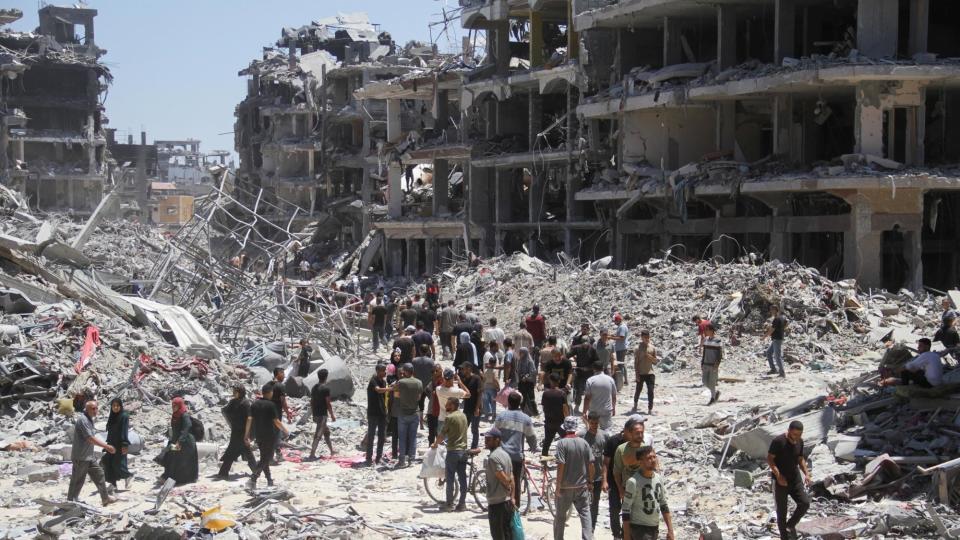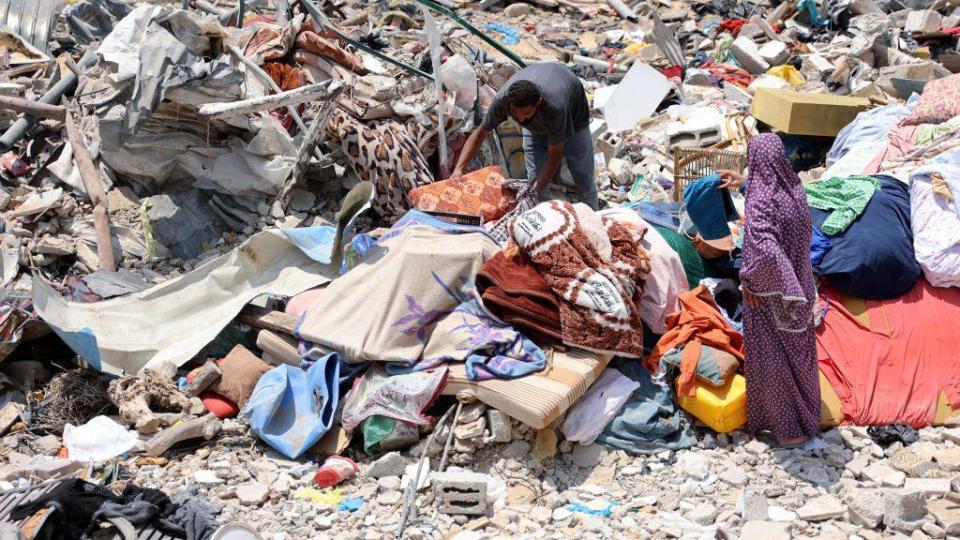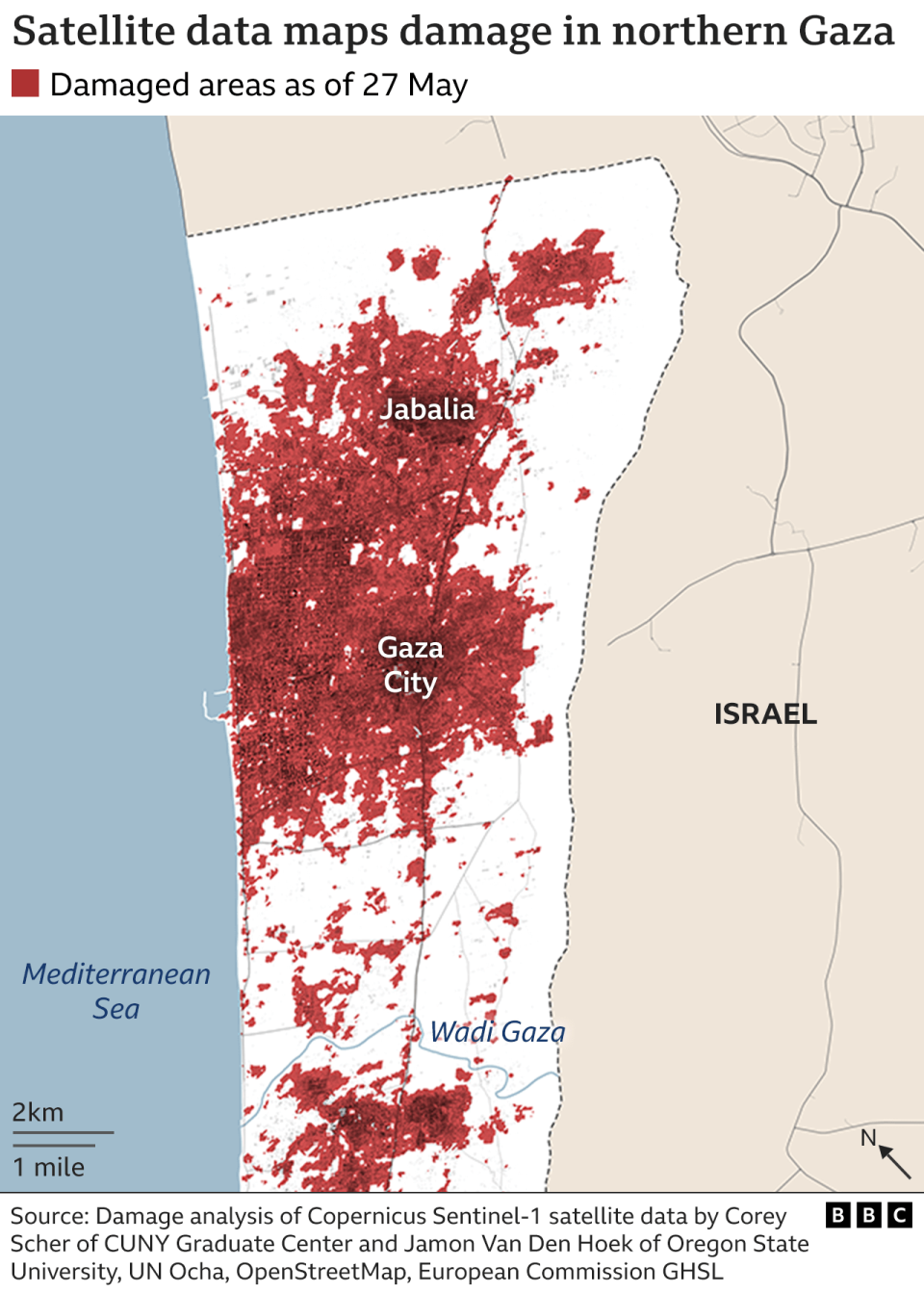Palestinians who have returned to the Jabalia refugee camp in northern Gaza in recent days have expressed shock at the level of destruction following a three-week Israeli military operation there against Hamas and other Palestinian armed groups.
A displaced man who was among more than 60,000 people who fled heavy fighting and bombing in the camp and surrounding area last month said he witnessed “horrific scenes.”
“Even the sand beneath our feet is scorched; it is unbearable to walk any further,” he told BBC Arabic. “The streets are littered with rubble and demolished buildings. Words are inadequate to describe the devastation.”
The man – who did not want to be named – also said he had seen injured and dead people “lying on the ground” and essential services and goods unavailable.
“There is no electricity and water. There are no clinics or medicines,” he added. “Water wells have been destroyed, shops and supermarkets demolished and there is a shortage of food.”

The city of Jabalia and its decades-old urban refugee camp – the largest in Gaza, with more than 110,000 registered residents – witnessed weeks of devastating bombings and fighting after the outbreak of war between Israel and Hamas in October.
The Israeli Defense Forces (IDF) said troops took control of the camp in late December after a series of operations in which it said “many terrorists” were killed.
It subsequently scaled back combat operations in northern Gaza and declared that local Hamas battalions had been dismantled. But this created a power vacuum in which the group could rebuild itself.
On May 12, the IDF said troops were returning to Jabalia for an operation “based on intelligence information about efforts by Hamas to reassemble its terrorist infrastructure and operatives in the area.”
Fighting raged for the next three weeks as tanks and troops entered the refugee camp under cover of intense air and artillery attacks. A military official described the fighting as “perhaps the fiercest” they had seen in the past seven months.
On Friday, the IDF announced that troops had completed their mission, having “eliminated hundreds of terrorists in intense combat and close encounters” and destroyed dozens of “terrorist infrastructure and combat complexes.”
The forces also located and destroyed more than 10 km of an underground tunnel network and recovered the bodies of seven Israelis taken hostage by Hamas in October, the report said.


Displaced families were soon seen walking back to the camp along streets lined with destroyed buildings, carrying the remains of their belongings.
A spokesman for the Hamas-led civil protection force in Gaza, Mahmoud Bassal, said on Friday that rescue teams in the Jabalia camp had found dozens of bodies, mostly women and children – including 30 members of one family.
On Sunday, the director of Kamal Adwan Hospital in the neighboring town of Beit Lahia, Dr Husam Abu Safiyeh, told Al Araby TV that 120 bodies had been recovered from Jabalia and its surroundings, and many more were believed to be buried underground. rubble.
The identities of the dead were not yet clear. But IDF Arab spokesman Lt. Col. Avichay Adraee on Friday downplayed such reports, stressing to X that they were members of Hamas and other armed groups.
Mr Bassal also said that Israeli forces had destroyed most of the houses in the camp, as well as the central market and almost all of its infrastructure.
He added that the fifth floor of al-Awda Hospital in Jabalia had been destroyed, along with the main electrical generators in Kamal Adwan.
The head of the Municipal Emergency Committee for North Gaza, Naji Sarhan, declared the city of Jabalia, the Jabalia camp, Beit Lahia and nearby Beit Hanoun as “disaster areas” on Sunday, estimating that 50,000 homes could be built there, according to a UN assessment. were destroyed. report.
He appealed to the international community for immediate assistance with shelter and support in repairing wells and other critical infrastructure.
The UN agency for Palestinian refugees, Unrwa, meanwhile, said it had received “horrifying reports” from the Jabalia camp, where it provides services.
They included displaced persons, including children, who were reportedly killed and injured while sheltering in an Unrwa-run school under siege by Israeli tanks, according to a post on X, formerly Twitter. There were also reports that Unrwa offices were destroyed by airstrikes and bulldozed by Israeli forces, it added.
Unrwa chief Philippe Lazzarini said thousands of people from the camp now had “no choice but to live amid the rubble and in destroyed Unrwa facilities.”


One of the returnees told BBC Arabic’s Gaza Lifeline program that he and his seven-year-old son “saw the bodies of martyrs all over the streets” on Saturday.
“East Jabalia is subject to unprecedented devastation,” Diab Abu Salama said. “All shops in Jabalia have been destroyed, as have the houses around them.”
“There is no doubt that this is the purpose of the occupation [Israel] By displacing people and destroying their homes and shops, they are forced to leave this country,” he asserted, before adding: “But we will remain steadfast.”
Musaed Zaqzouq, meanwhile, described how he found only rubble where his house had stood three weeks ago.
“The scene was very horrible,” he said. “The parental home was completely destroyed, just like the neighborhood in which I lived.”
“Water pipes were destroyed… sewerage channels were damaged,” he added. “There is no longer one suitable place to live.”
One woman, who did not want to be named, said the destruction was so great that “we are walking through the streets as if we are seeing them for the first time”.
She also urged the international community to take action to help Palestinians in Jabalia and elsewhere in Gaza.
“What is the reason for all this mass destruction?” she asked. “Please hurry and come to us to see how much pain we are in.”
Israel launched a military campaign in Gaza to destroy Hamas in response to the group’s cross-border attack on southern Israel on October 7, which killed around 1,200 people and took 251 others hostage.
At least 36,470 people have been killed in Gaza since then, according to the Hamas-run Health Ministry.








